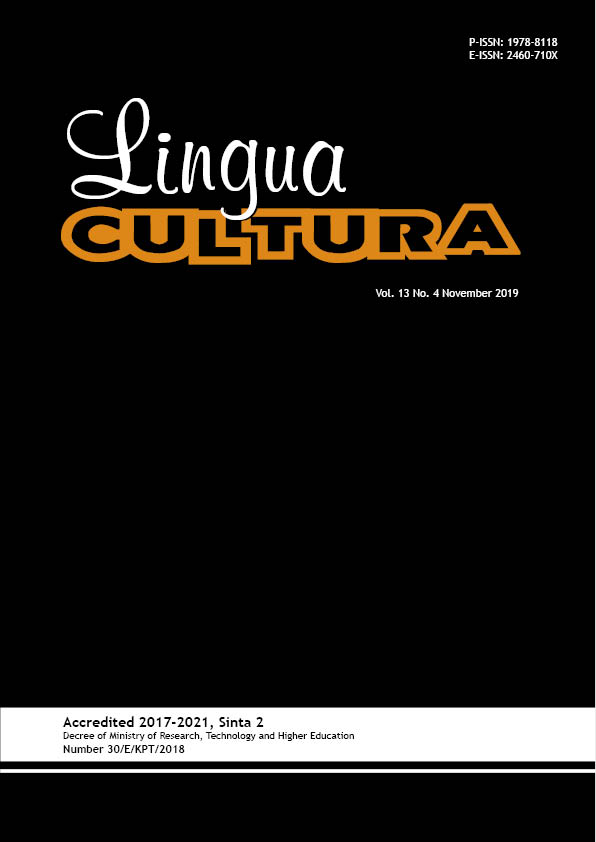Incorporating Youtube Clips in the Classroom to Develop Students’ Cultural Understanding of American Culture
DOI:
https://doi.org/10.21512/lc.v13i4.5889Keywords:
teaching culture, YouTube video clips, student understanding, cultural understandingAbstract
This research investigated the use of YouTube video clips to develop the understanding of culture for students in American Culture class in a private university in Bandung. It sought to answer two research problems; first, students’ perceptions towards the use of YouTube video clips to develop their understanding of American culture; second, to what extent watching YouTube video clips supported the students’ understanding of American culture. The participants of this research were 61 undergraduate students of the English Department aged between 18-21 years. There were two types of data collection used in the research. First, data were taken from the weekly learning logs of the students containing three to five questions and one or two YouTube video clips, which were related to the topics of the textbook in the classroom. Second, the data from the open-ended questionnaire which were distributed to the students at the end of the semester. The qualitative data were analyzed using thematic analysis. The findings show that the students’ understanding of American culture has improved due to watching YouTube video clips that contain authentic cultural information from American life events and news shown in the clips. This research also provides useful information for teachers in teaching culture for a better learning process, which focuses on the use of YouTube video clips in the classroom.
Â
References
Almurashi, W. (2016). The effective use of YouTube videos for teaching English language in classrooms as supplementary material at Taibah University in Alula. International Journal of English Language and Linguistics Research, 4(3), 32–47.
Creswell, J. W. (2012). Educational research: Planning, conducting, and evaluating quantitative and qualitative research. Boston: Pearson Education Limited.
Dai, L. (2011). Practical techniques for cultural-based language teaching in the EFL classroom. Journal of Language Teaching and Research, 2(5), 1031–1036. https://doi.org/10.4304/jltr.2.5.1031-1036.
Dema, O., & Moeller, A. (2012). Teaching culture in the 21st century language classroom. Touch the World: Selected Papers from the 2012 Central States Conference on the Teaching of Foreign Languages. Nebraska, United States of America. pp 75–91.
June, S., Yaacob, A., & Kheng, Y. K. (2014). Assessing the use of YouTube videos and interactive activities as a critical thinking stimulator for tertiary students: An action research. International Education Studies, 7(8), 56-67. https://doi.org/10.5539/ies.v7n8p56.
Kabooha, R., & Elyas, T. (2018). The effects of YouTube in multimedia instruction for vocabulary learning: Perceptions of EFL students and teachers. English Language Teaching, 11(2), 72-81. https://doi.org/10.5539/elt.v11n2p72.
Maryani. (2016). Advantages of experiencing culture in learning and understanding American culture: A case study of Indonesian University students. Bali 9th International Conference on Business Economics Social Science and Humanities. Bali, Indonesia.
Maryani, M., & Aguskin, L. C. (2018). University students’ understanding on cultural activities in American culture class. Lingua Cultura, 12(2), 169-177. https://doi.org/10.21512/lc.v12i2.4043.
Moran, P. R. (2001). Teaching culture: Perspectives in practice. Boston: Heinle & Heinle.
Nova, M. (2017). Utilizing video for technology integration support in Indonesian EFL classroom: Usages and obstacles. Indonesian Journal of EFL and Linguistics, 2(1), 15-28. https://doi.org/10.21462/ijefll.v2i1.28.
RodrÃguez, L. F. G. (2014). Relational teaching: A way to foster EFL learners’ intercultural communicative competence through literary short stories. Colombian Applied Linguistics Journal, 16(2), 135-150. https://doi.org/10.14483/udistrital.jour.calj.2014.2.a01.
Silviyanti, T. M. (2014). Looking into EFL students’ perceptions in listening by using English movie videos on YouTube. Studies in English Language and Education, 1(1), 42-58. https://doi.org/10.24815/siele.v1i1.1119
Solgi, F., & Tafazoli, D. (2018). The necessity of teaching culture in English as a foreign language course: Iranian perspective. Journal of Language and Linguistic Studies, 14(3), 1–11.
Styati, E. W. (2016). Effect of YouTube videos and pictures on EFL students’ writing performance. Dinamika Ilmu, 16(2), 307–317.
Terantino, J. (2011). Emerging technologies YouTube for foreign languages: You have to see this video. Language Learning & Technology, 15(1), 10–16.
Truong, L. B., & Tran, L. T. (2014). Students’ intercultural development through language learning in Vietnamese tertiary education: A case study on the use of film as an innovative approach. Language and Intercultural Communication, 14(2), 207–225. https://doi.org/10.1080/14708477.2013.849717.
Utami, F., Tyas, M. A., & Mustika, N. (2019). The use of commercial advertisement to teach university students in English for specific purpose context. Lingua Cultura, 13(2), 151–159. https://doi.org/10.21512/lc.v13i2.5297.
Yükseli, C., & Kömür, S. (2017). Using online videos to improve speaking abilities of EFL learners. European Journal of Education Studies, 3(5), 255-266. https://doi.org/10.5281/zenodo.495750.
Downloads
Published
How to Cite
Issue
Section
License
Authors who publish with this journal agree to the following terms:
a. Authors retain copyright and grant the journal right of first publication with the work simultaneously licensed under a Creative Commons Attribution License - Share Alike that allows others to share the work with an acknowledgment of the work's authorship and initial publication in this journal.
b. Authors are able to enter into separate, additional contractual arrangements for the non-exclusive distribution of the journal's published version of the work (e.g., post it to an institutional repository or publish it in a book), with an acknowledgment of its initial publication in this journal.
c. Authors are permitted and encouraged to post their work online (e.g., in institutional repositories or on their website) prior to and during the submission process, as it can lead to productive exchanges, as well as earlier and greater citation of published work.
USER RIGHTS
All articles published Open Access will be immediately and permanently free for everyone to read and download. We are continuously working with our author communities to select the best choice of license options, currently being defined for this journal as follows: Creative Commons Attribution-Share Alike (CC BY-SA)


















